The curtain fell on the champion of the African Cup of Nations 2023, as Ivory Coast won the title for the third time in history, after they won the tournament in the 1992 and 2015 editions, following an exciting journey in an exciting tournament.
We can say that Elephants came back from death in this tournament after losing hope and firing the coach, Jean-Louis Gasset, for getting the third place, which is a disaster for a host country, but fate wanted them to be served by the circumstances to get a qualifying seat among the best thirds, so the Elephants rose and took advantage of the opportunity in the best way possible.
It must be said that the Eagles of Nigeria presented a good tournament and a strong journey to reach the final match, conceding only one goal and offering a remarkable performance, which made the final match intense and decided in the last minutes.
In this tactical analysis, we will find out whether the awakening of the Elephants was just a moral boost or Emerse Faé changed some tactics or players that made them win over Nigeria or at least not concede any dangerous chances or goals from open play.
Lineups and formations
The Elephants started the match with a 4-3-3 formation, with Yahia Fofana between the sticks behind Serge Aurier as the right-back and Ghislain Konan as the left-back, along with Odilon Kossounou and Evan Ndicka as the centre-backs.
In front of them comes the brilliant midfield trio of Seko Fofana, Franck Kessié, and Jean Michaël Seri. After that, Emerse Faé chose Simon Adingra and Max-Alain Gradel as the two wingers behind Sébastien Haller.
Meanwhile, the Eagles started with their usual 3-4-3 formation, with Stanley Nwabali in goal behind a defensive trio of Semi Ajayi, William Troost-Ekong and Calvin Bassey. At the same time, their wingbacks were Ola Aina and Zaidu Sanusi. In front of them, they have the two pivots, Frank Onyeka and Alex Iwobi. At the attack line, they had Alex Iwobi and Samuel Chukwueze behind their excellent striker Victor Osimhen.
Nigeria in possession vs Ivory Coast out of possession
To understand what happened well, we need to return to their match in the group stage when Nigeria beats Ivory Coast 1-0 to see Nigeria’s strengths, which met Ivory Coast’s weaknesses, making the Eagles better in this phase. However, the formations of the two teams remain the same.
As shown below, Ivory Coast depends on high pressing with the shown scheme asking the striker to press against the three defenders, but with an arched run to cut the passing lane to the other direction, hoping to implement a side pressing while asking the winger near the ball to be ready to press the defender in the direction the ball goes.
The two pivots are responsible for Nigeria’s two pivots in man-marking.
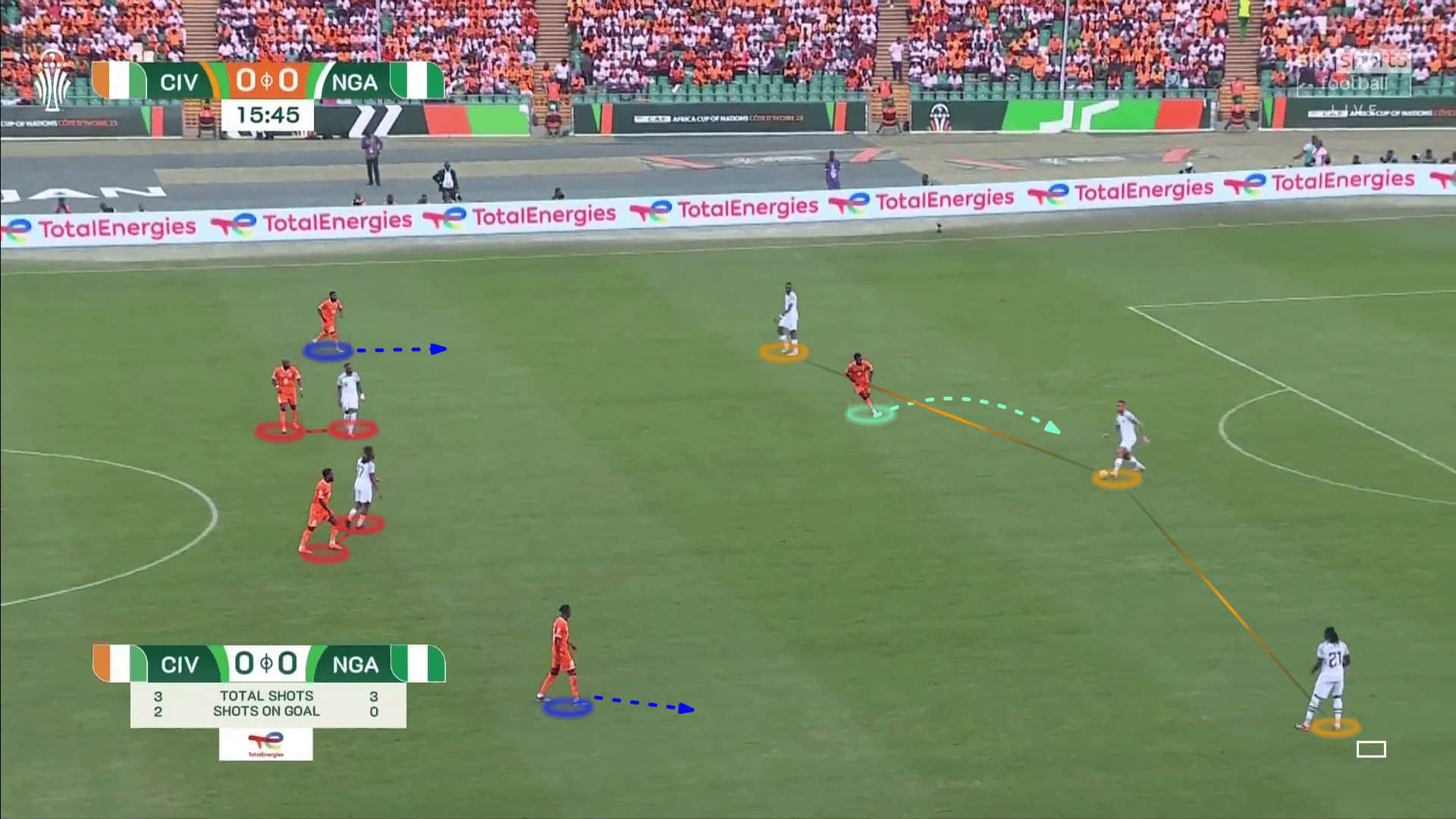
This man-marking system in the midfield makes the half spaces easily exploited by the Eagles as the two wingers can act more as two insiders exploiting that the wing-backs fix the two opposition full-backs. It is clear that Ivory Coast’s six is in a rush and not ready to cover behind the two eights, as shown in the two photos below.
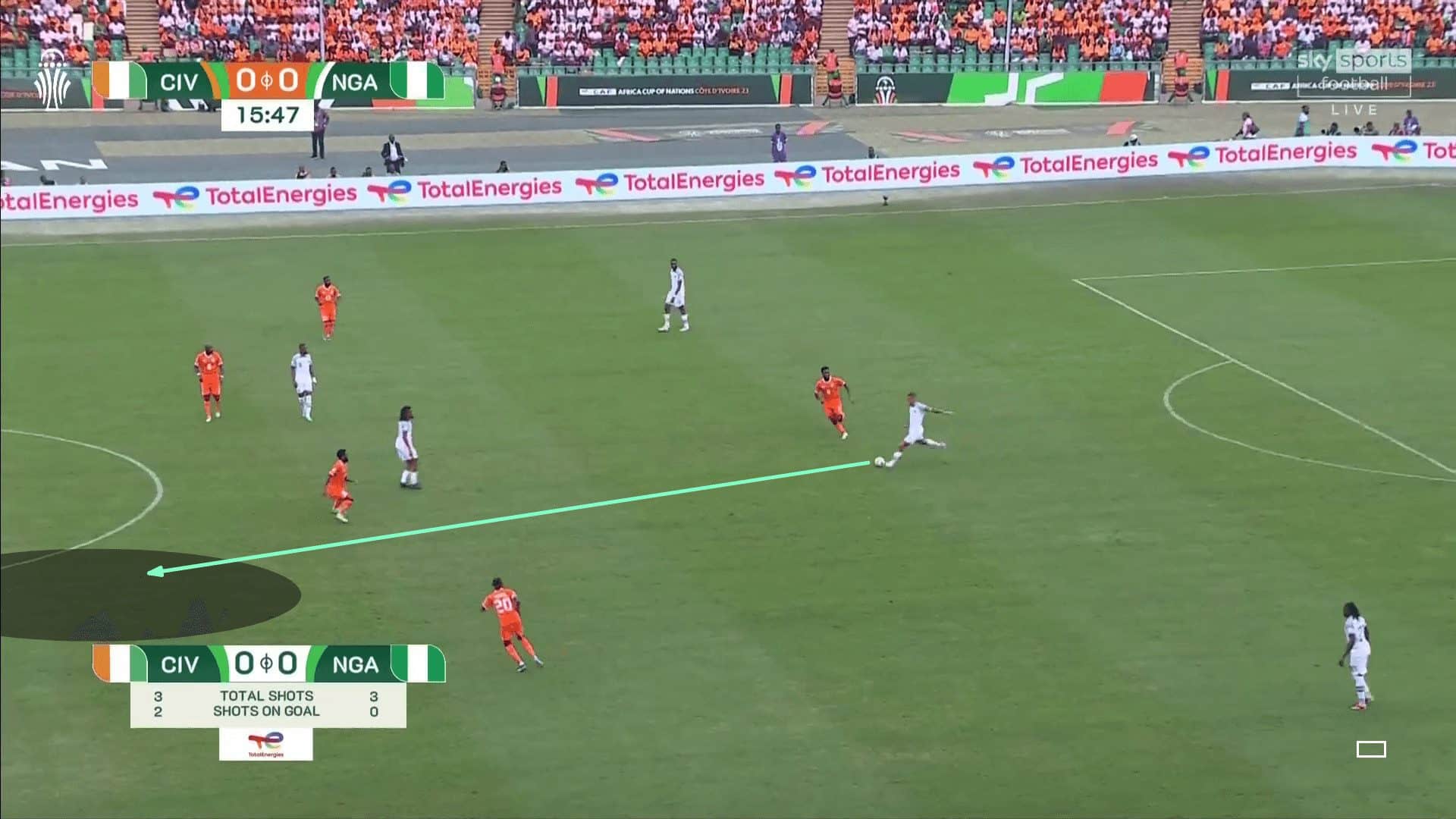
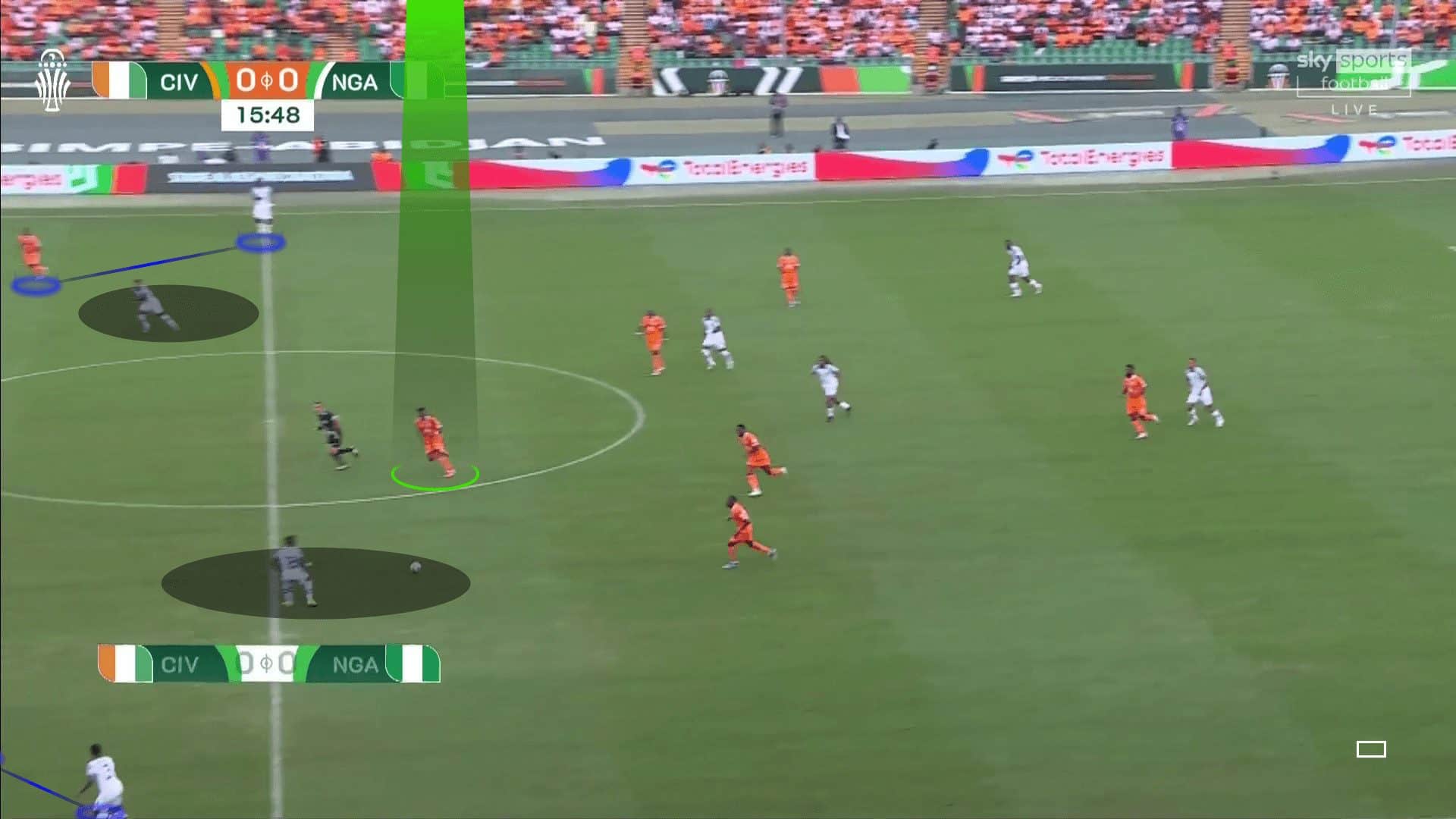
And it always ends with a 2-v-1 situation against the full-back.
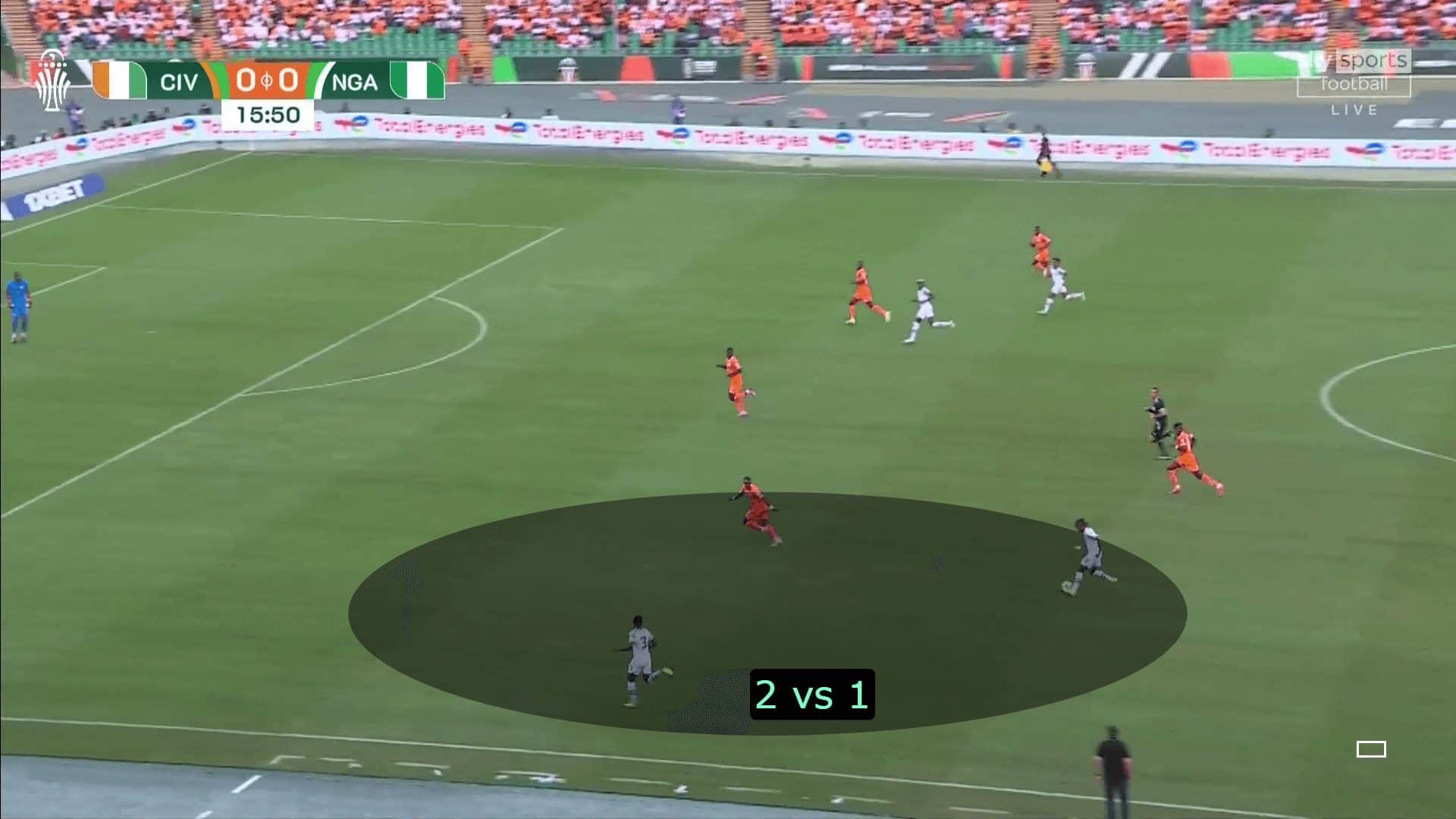
And suppose the full-back decides to fill this gap, as in the case below. In that case, Osimhen moves in the space he left, so the defence line gets forced to shift, which is always difficult if Nigeria decides to change the direction of play using their wide wing-back on the other side while the inside winger moves inside to drag the full-back.
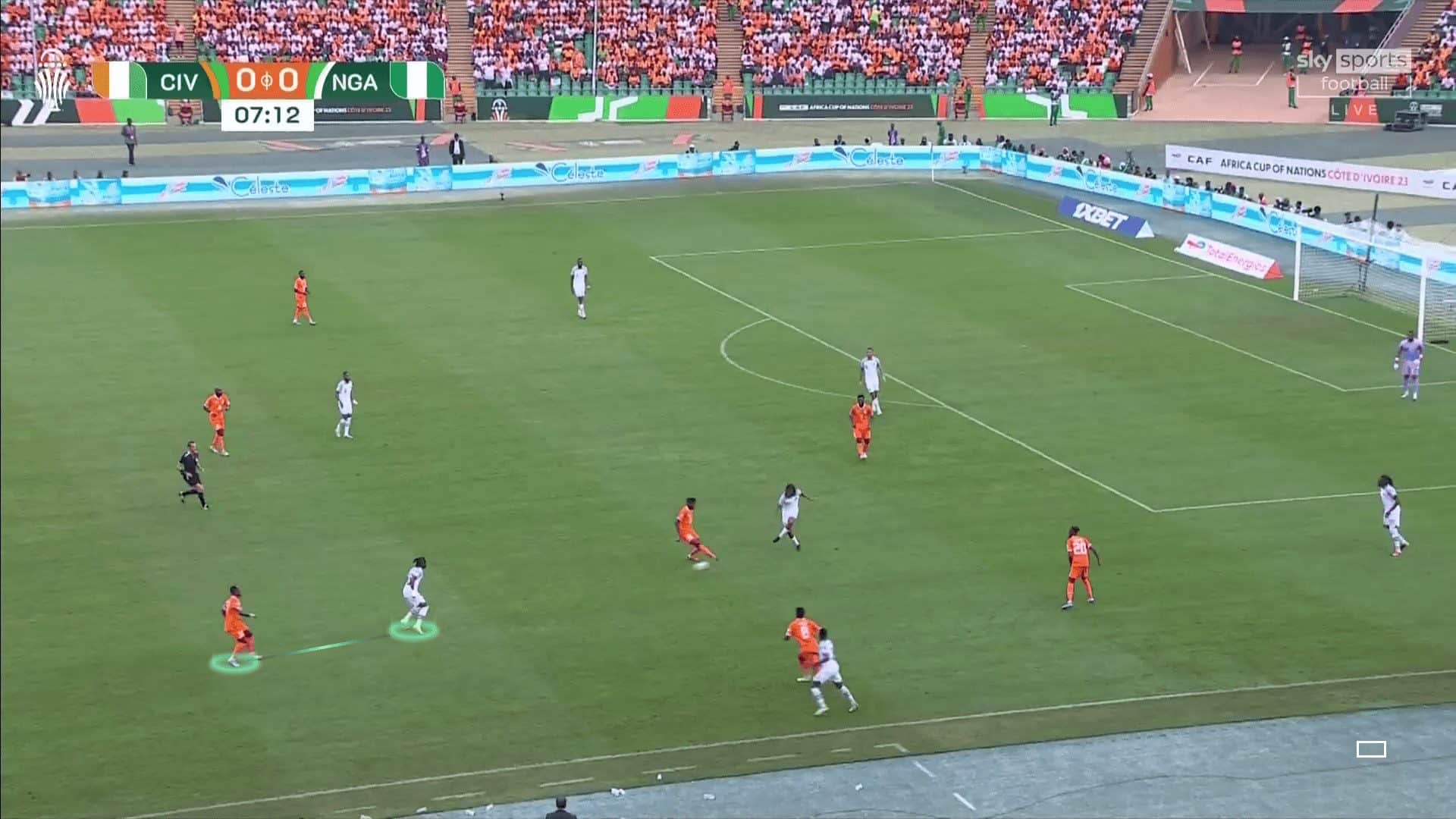

After this back short journey, we come back to see how the new Ivorian coach, Emerse Faé, dealt with that, and let’s start with the photo below, which clarifies many things; let’s go deeply step by step.
The Elephants now step back in a mid-block while asking the striker to do the same thing: to stand against the Nigerian defending trio trying to cut the passing lane to the other direction when possible. The two wingers don’t go to the defenders, as in the previous match, having instructions to be close to the wingbacks and keep tracking them to make the defending line narrow to be responsible for the narrow Nigerian trio.
The two pivots are with the Nigerian two pivots as in the previous case but with instructions for the brilliant Jean Michaël Seri, in white, to cover them by moving to the ball’s side to cut any pass to the half-spaces.
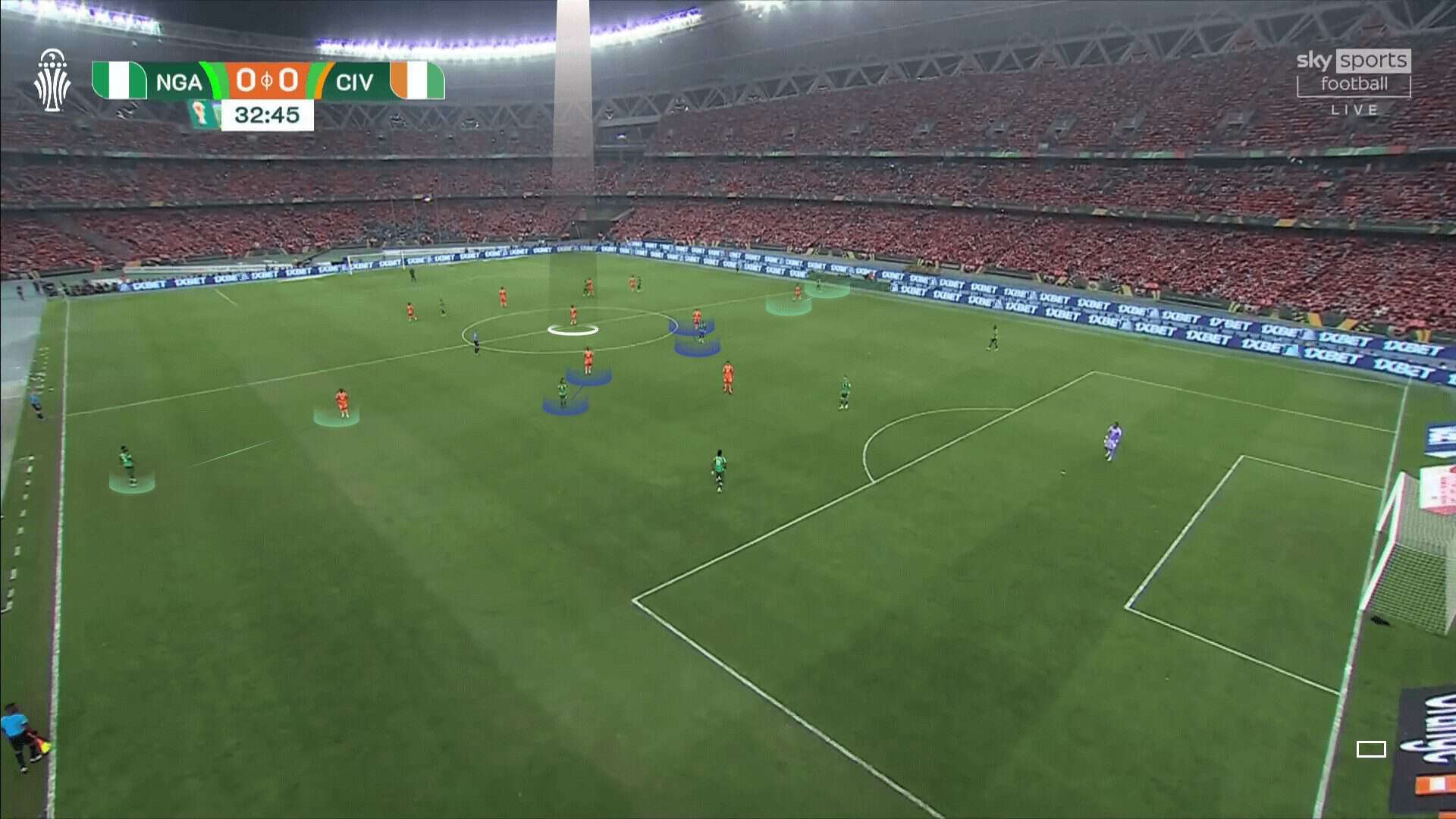
When the ball is passed in the right direction, you see below the great shifting by asking the pivot near the ball to press the right centre-back instead of the winger in the first match. In contrast, the other pivot covers him going to the Nigerian pivot near the ball and the holding midfielder, in white, to be ready to cut the passing lane for the half-space.
The two wingers have different roles now, so the winger near the ball still tracks the wingback while the far one covers the middle because of the shift made there.
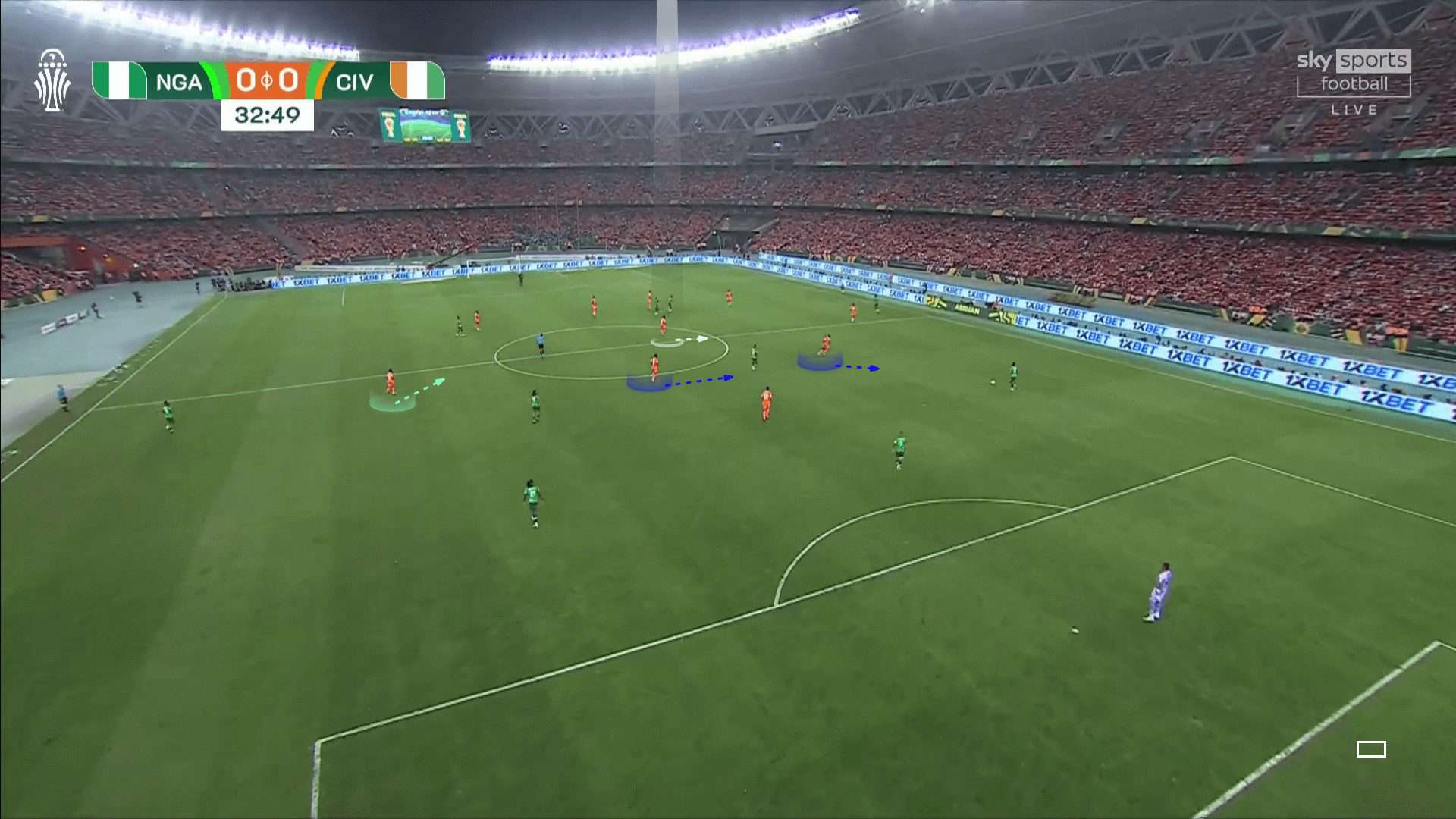
So, the ball is still with the Nigerian three defenders until the moment at which Haller manages to force the defender to pass by his arched run, so the free holding midfielder, in white, can cut the ball. At the same time, the far winger’s role comes in counterattack.
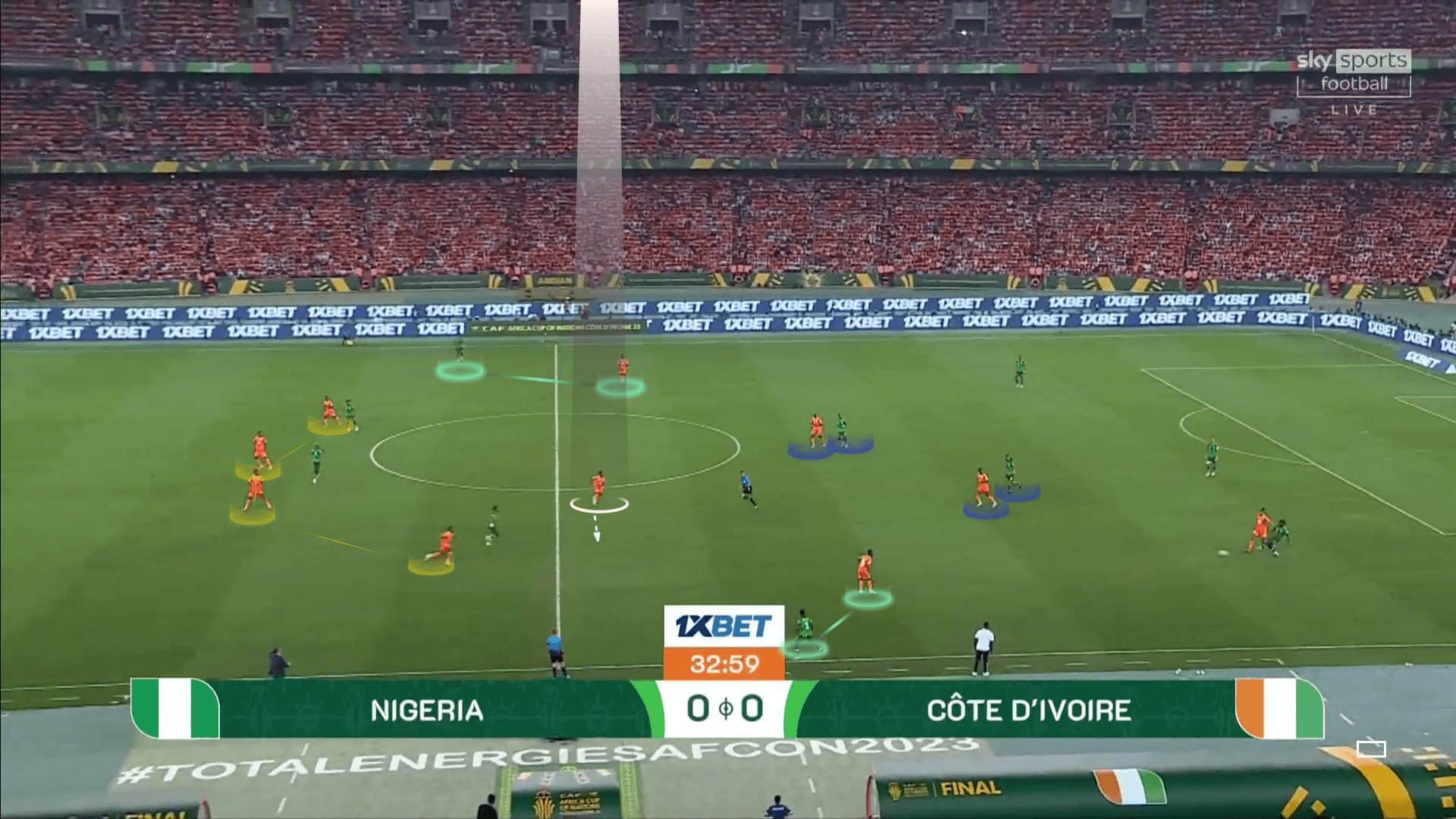
We are still with the same scene to show the intentions of Ivory Coast not only to defend against the wide wing-backs but also to exploit the space behind them, so you can see the holding midfielder cuts the ball, passing it to Haller, who drops to receive and pass to Kessié. In contrast, the far midfielder, Fofana, runs in front of the fullback to drag him to empty the space for the brilliant winger, Adingra, who gets the ball in a dangerous position, as in the fourth photo.
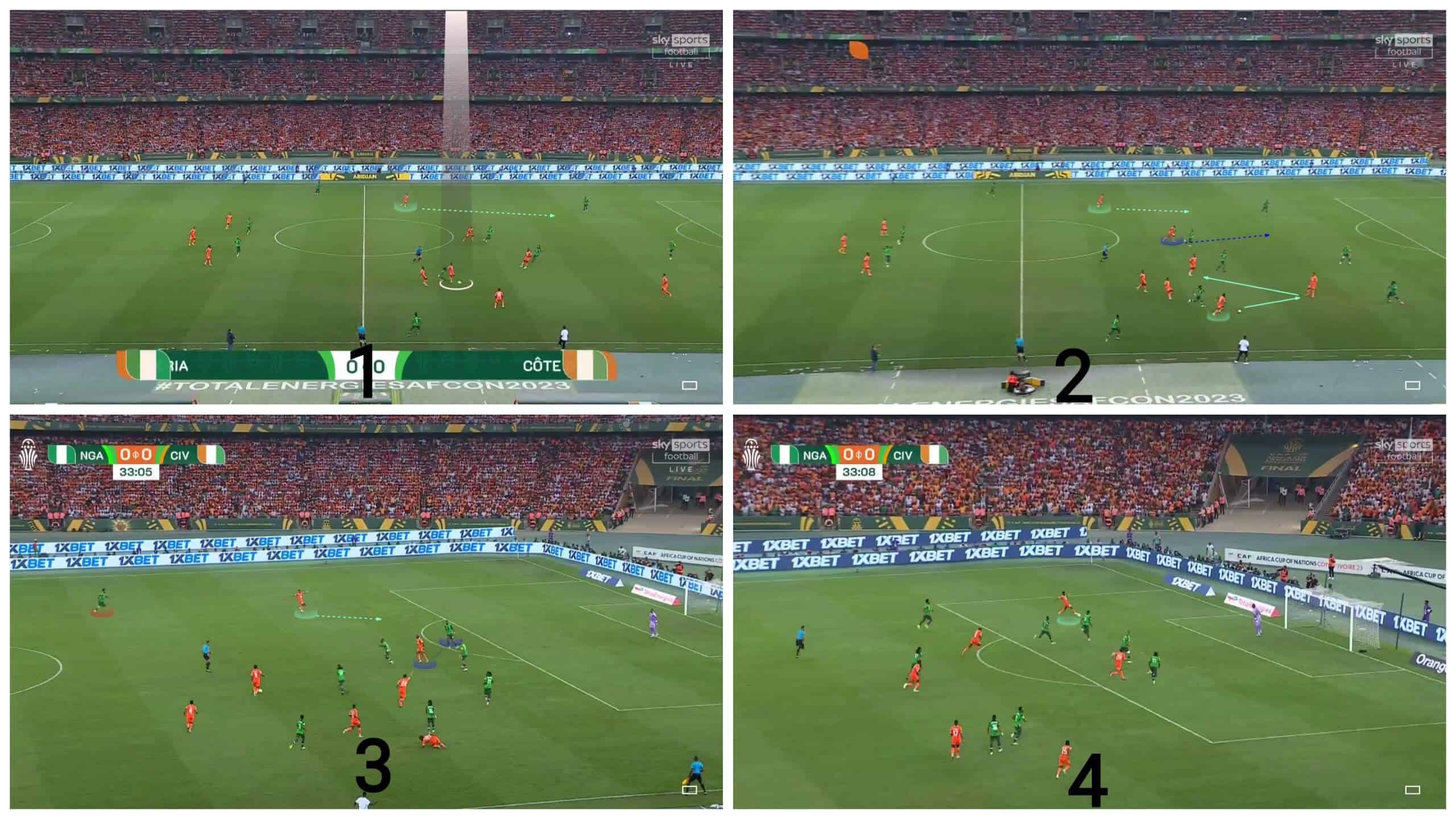
In pink below, we need to mention the essential tactical role of the far winger to cover the middle after the holding midfielder, in white, cuts the pass to the half-space near the ball, so the two half-spaces are protected now.
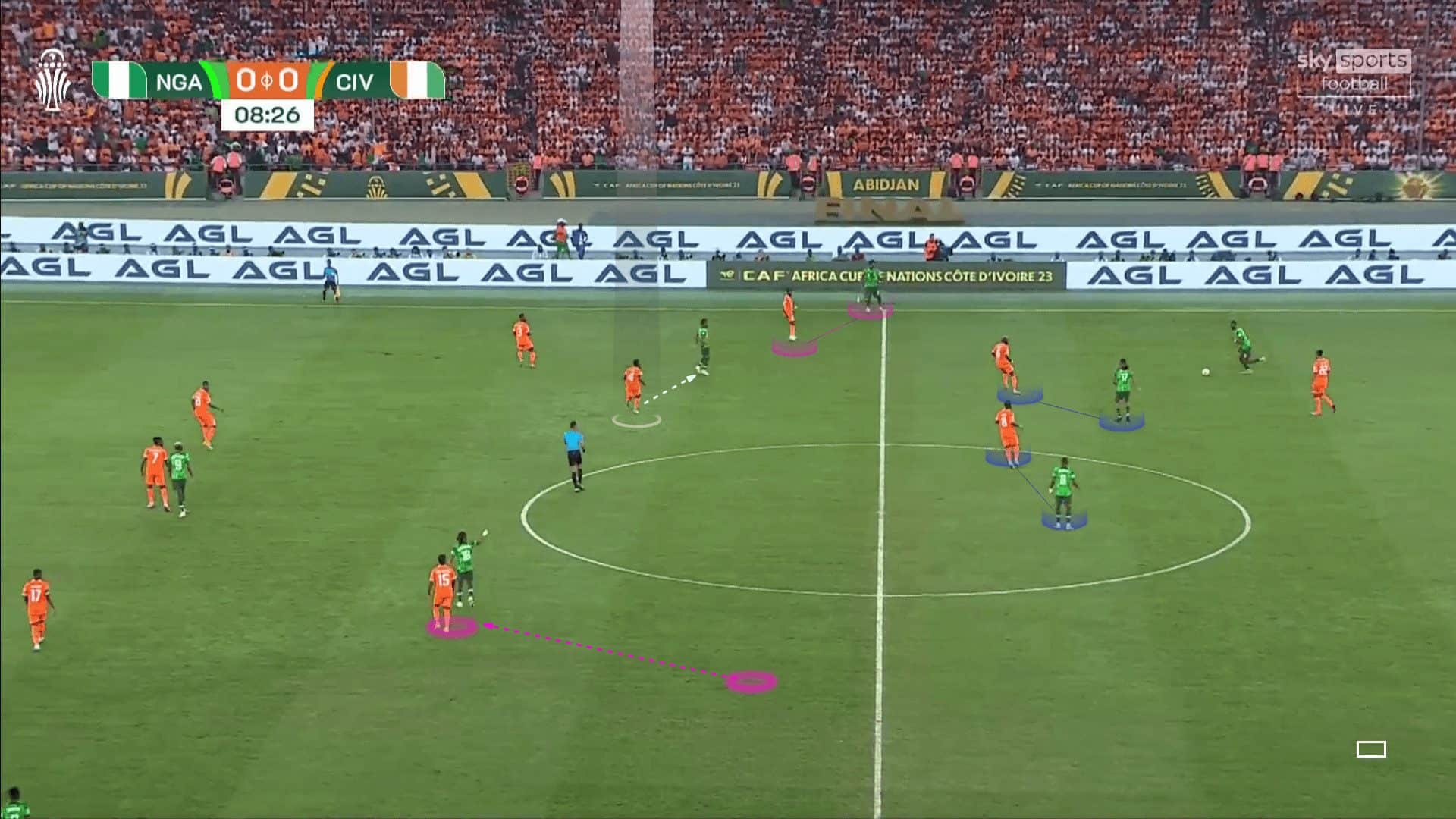
Ivory Coast in possession vs Nigeria out of possession
We can summarise the elephants’ intention with the ball by aiming to wing rotations with a trio in each direction, the fullback, the pivot near the ball and the winger to send crosses exploiting their brilliant striker, Haller, and this can happen in several ways, as we will explain.
As shown in the first photo below, Nigeria keeps using their 5-4-1 defending scheme in low or mid blocks by asking Osimhen to mark the holding midfielder, which makes it difficult for Ivory Coast to do any wing rotations, but they had the solution.
In the second photo, when the ball goes to a side, the holding midfielders drag Osimhen with him to make it far for him to return to the middle when the direction is changed, as in the third photo. This gives the right centreback, Odilon Kossounou, the space to dribble the ball while the two pivots are fixed. Then, they can do some wing rotations by four players using third-man passes after the Nigerian inside winger gets forced to go to him, as in the fourth photo below.
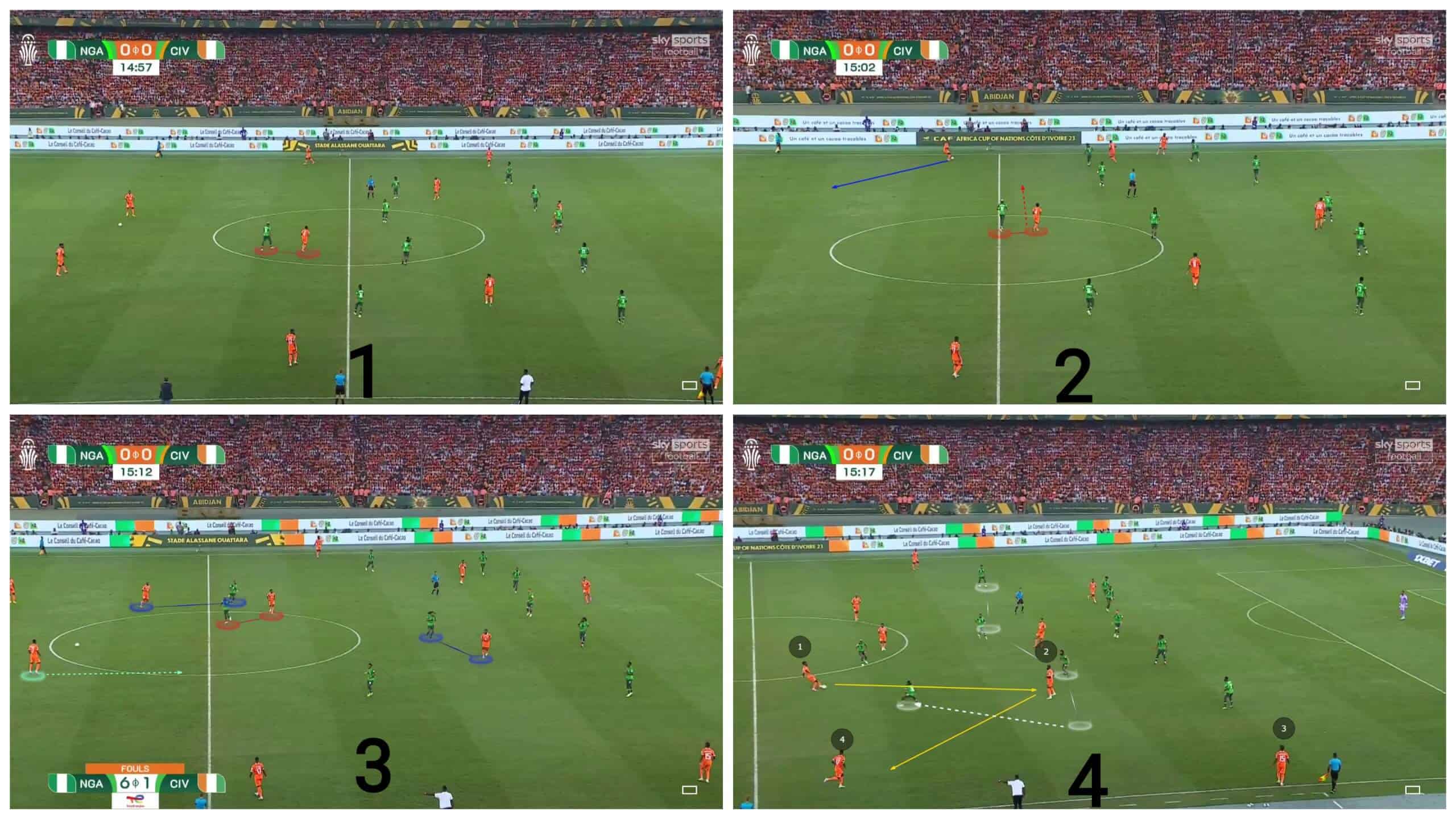
After that, they aim to send crosses to the striker and the far winger.
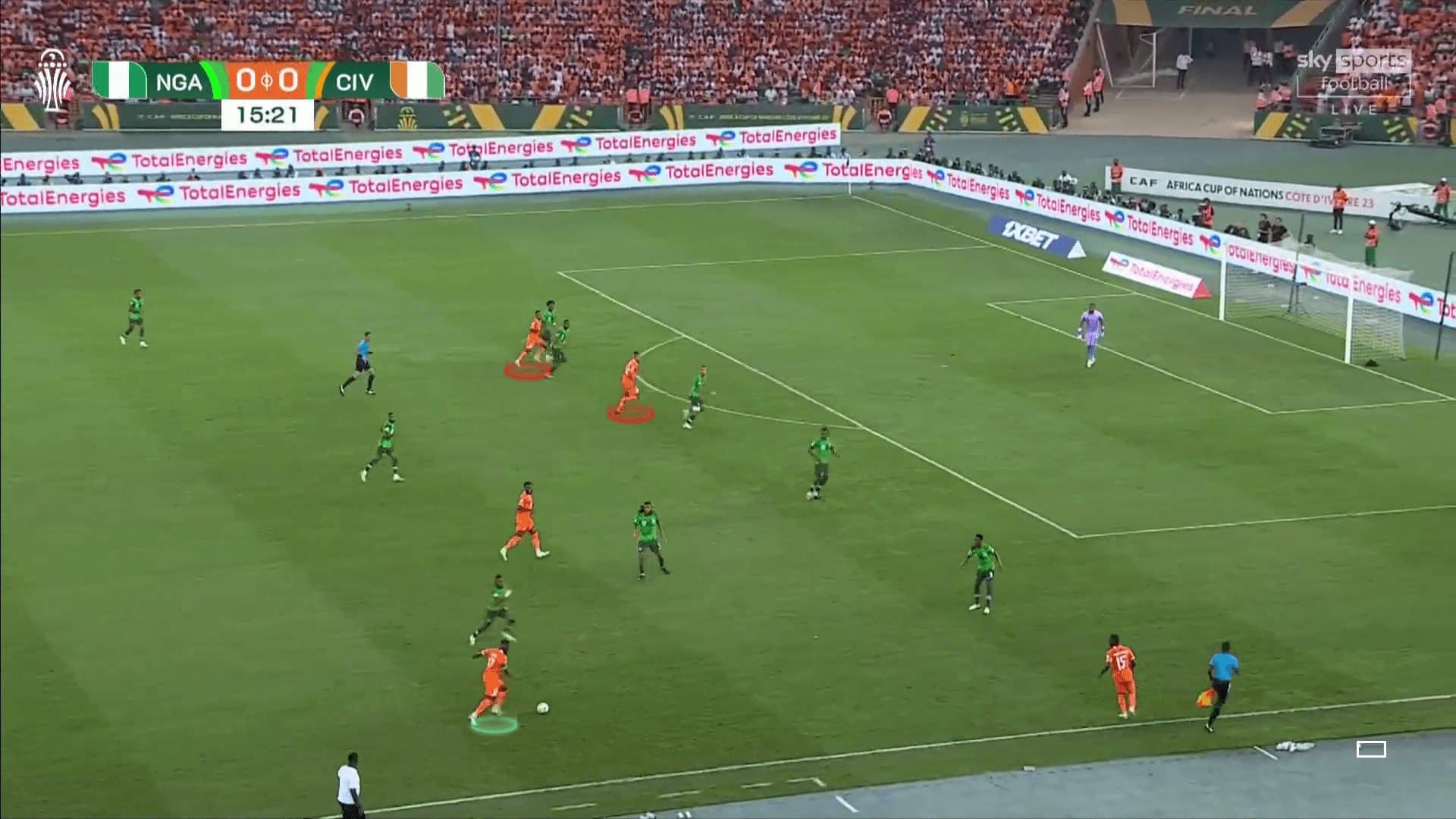
The same centre-back, Odilon Kossounou, was brave to dribble and send through passes to the far winger behind the defence line after Haller’s dropping to receive, but the pass hits Haller, as shown in the two photos below.
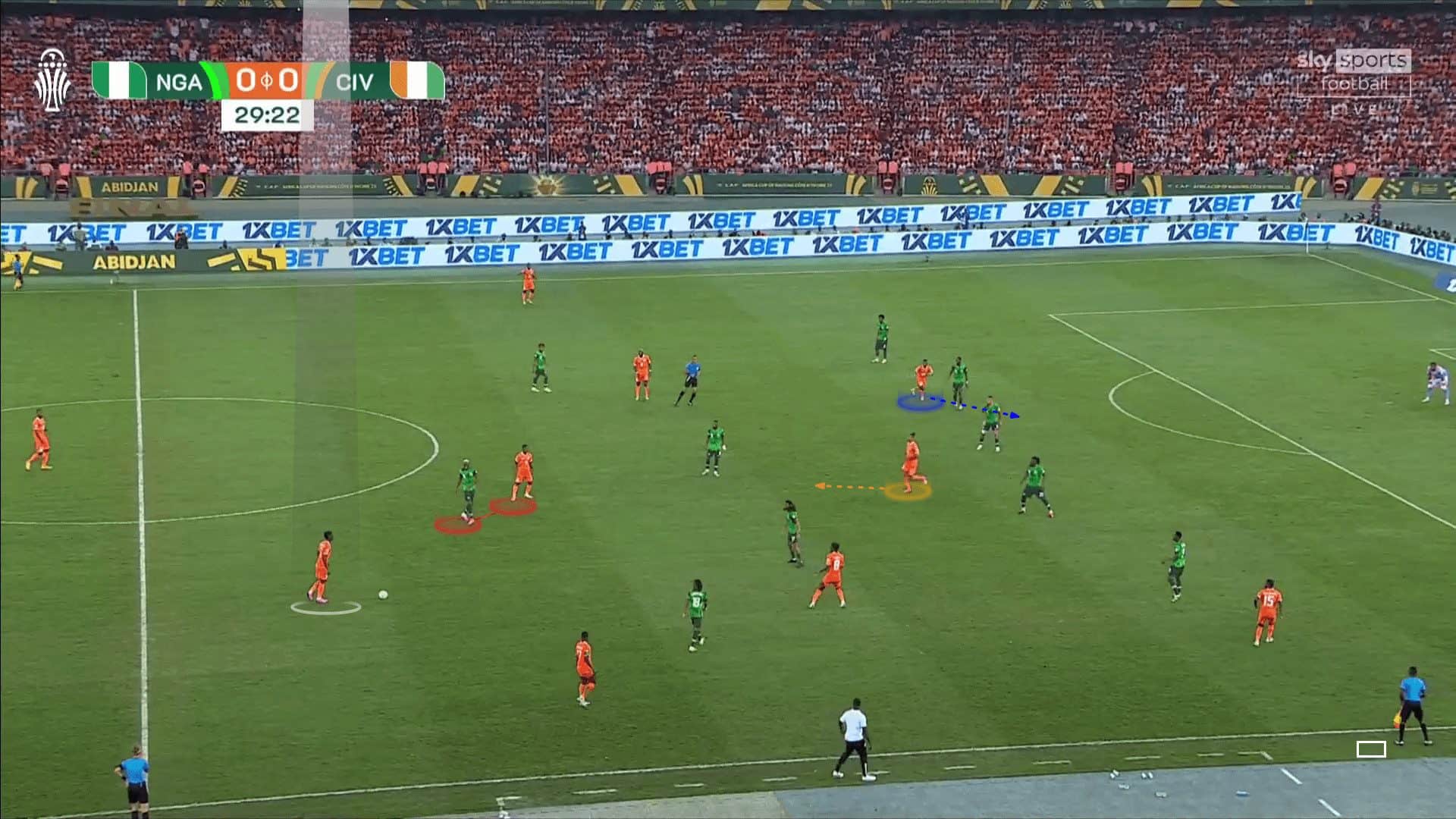
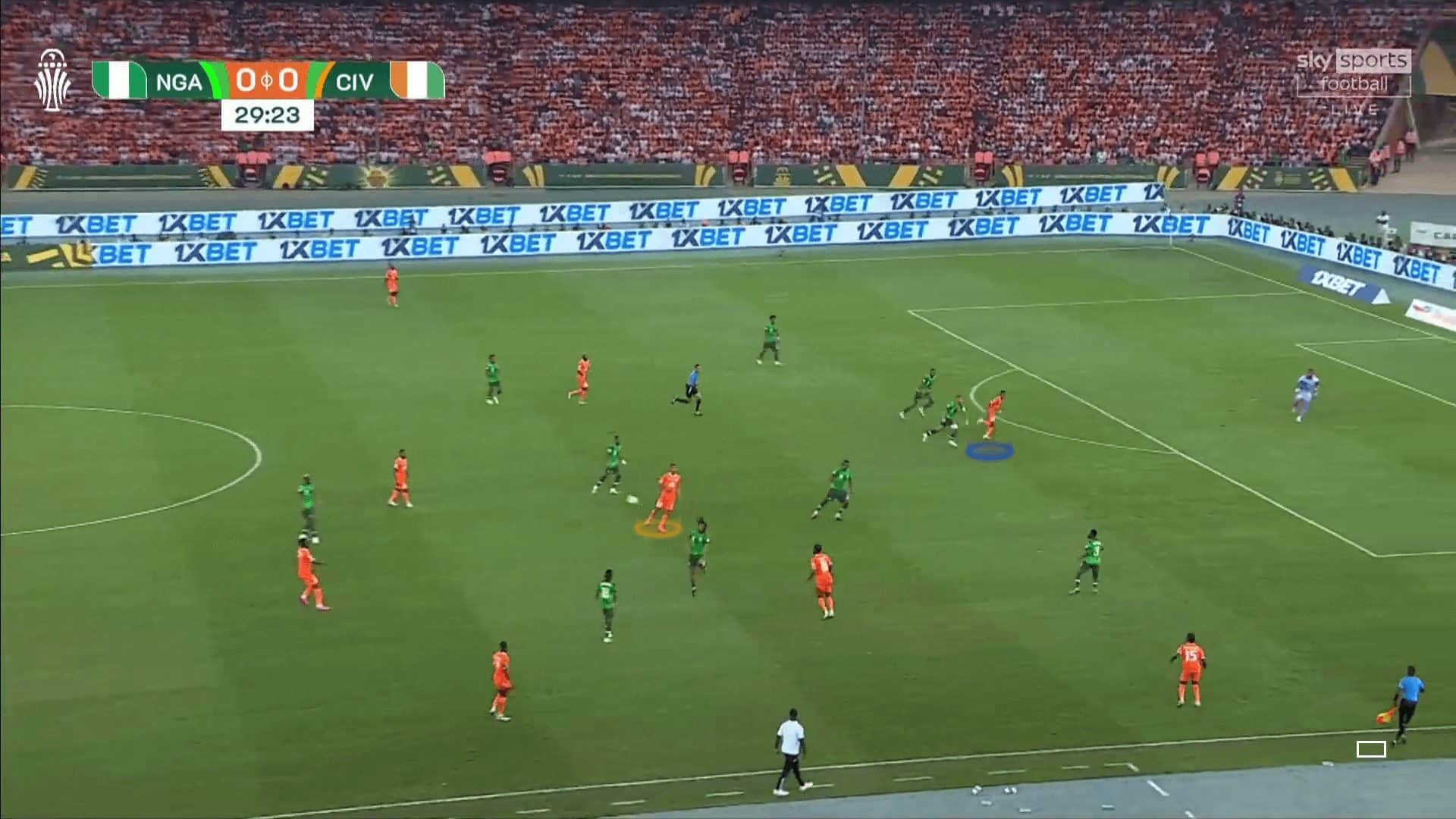
Now, we come to box attacking and how they depend on that, so you can see the brilliant winger, Adingra, having the ball while three players are inside the box, the striker, the far winger and the far midfielder, waiting in the box.
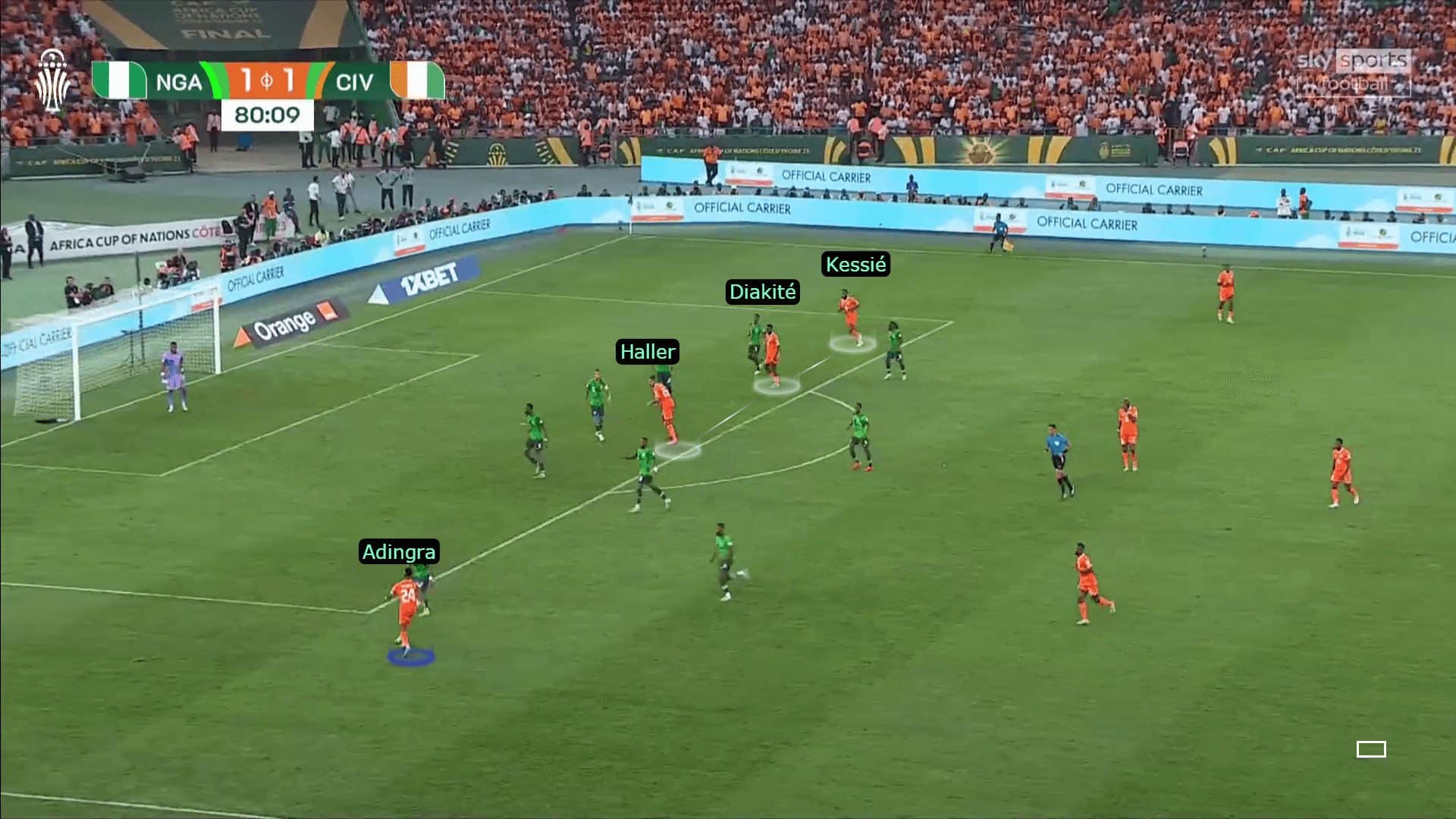
Adingra can pass the wingback skilfully and bow while three attackers are inside the box, making it easier for Haller, but we want to focus on his class A behaviour. He keeps himself behind the opponent, making the opponent between him and the ball. This puts him on the defender’s blind side while having another advantage, having two choices of moving behind and in front of the defender. He chooses the right timing to go to the ball, ending in the goalmouth, which is too good for the striker, as shown in the two photos below; the result is the winning goal.
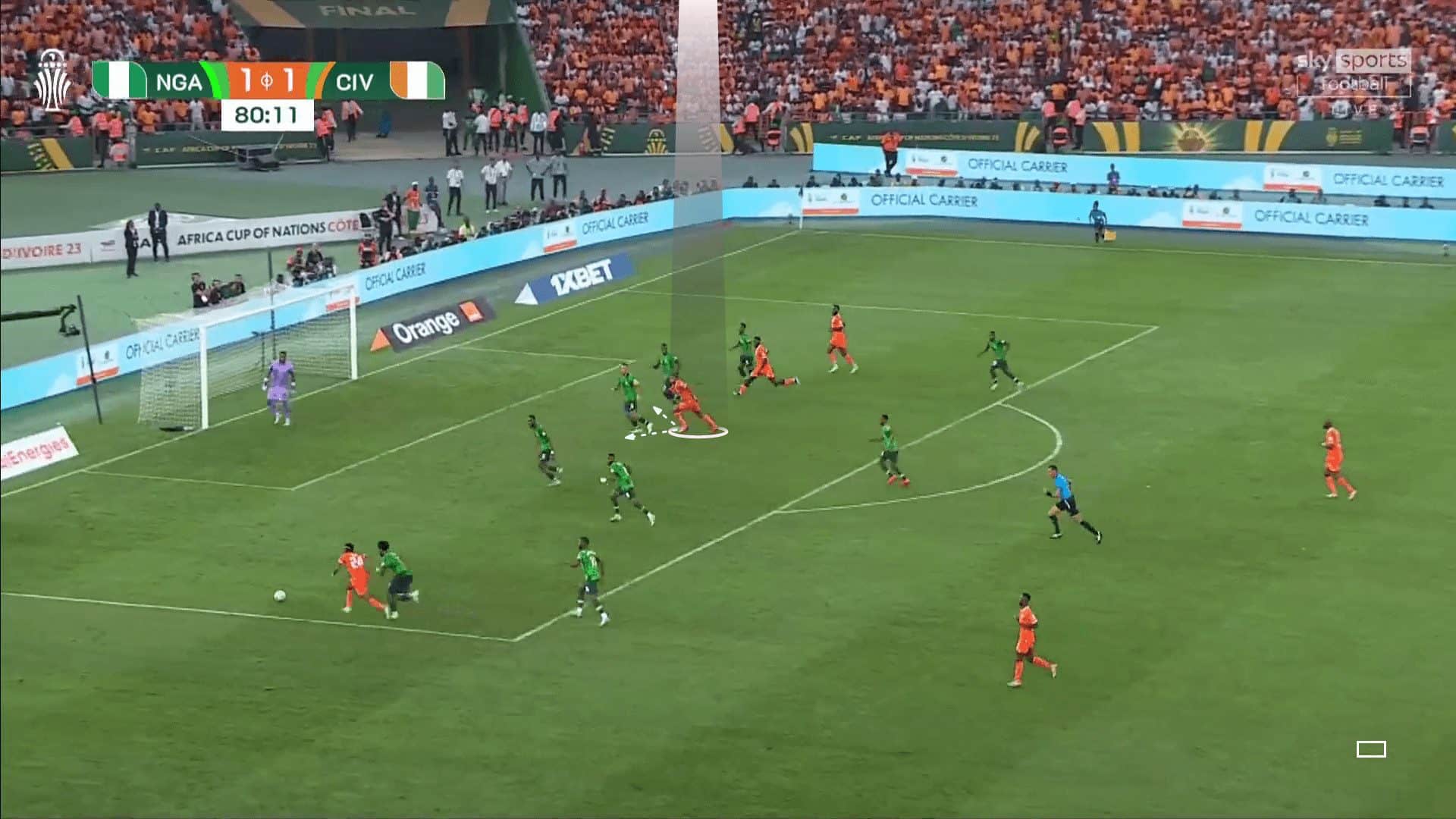
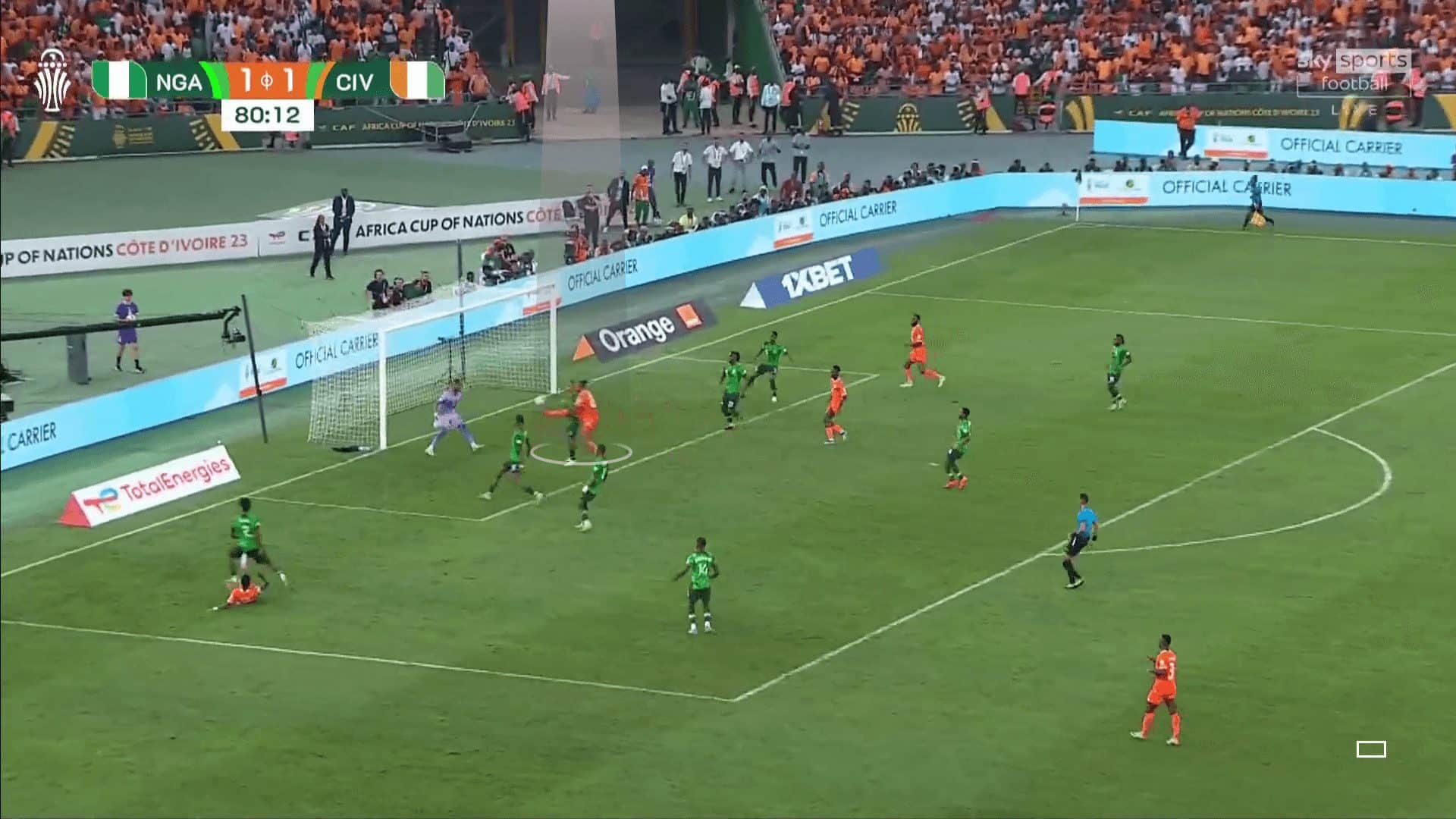
In this match, two of three goals come through set pieces, so we should mention that Ivory Coast exploited a weakness in Nigeria’s defending scheme in corners.
In the first photo below, Nigeria defends with six zonal players, asking the first one to go to the front to get the first touch and defend flicks, two man markers and two rebound defenders while asking one of them to defend short corners.
In the second photo, we want to focus on the last zonal defender, in yellow, who stands a lot inside, especially in in-swinging crosses, so the targeted area is the far edge of six six-yard in front of him while using two attackers, in white, to block the zonal player before him, and the man marker there, as in the third photo.
In the fourth photo, the last zonal player finds himself forced to go through all this distance to stop Kessié, the targeted player.
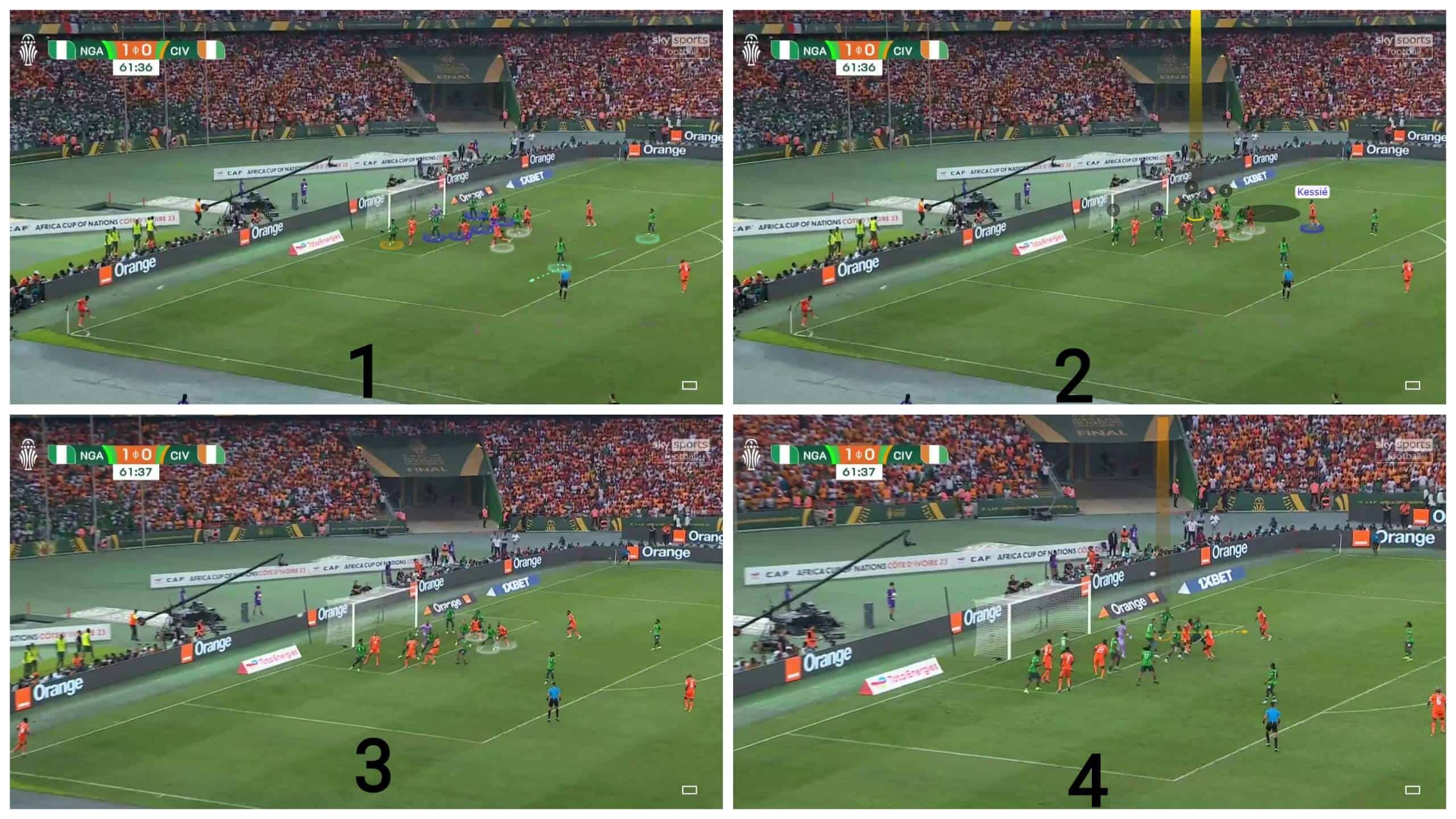
Kessié gets the ball before the last zonal player who took a long distance, and the result is the first goal.
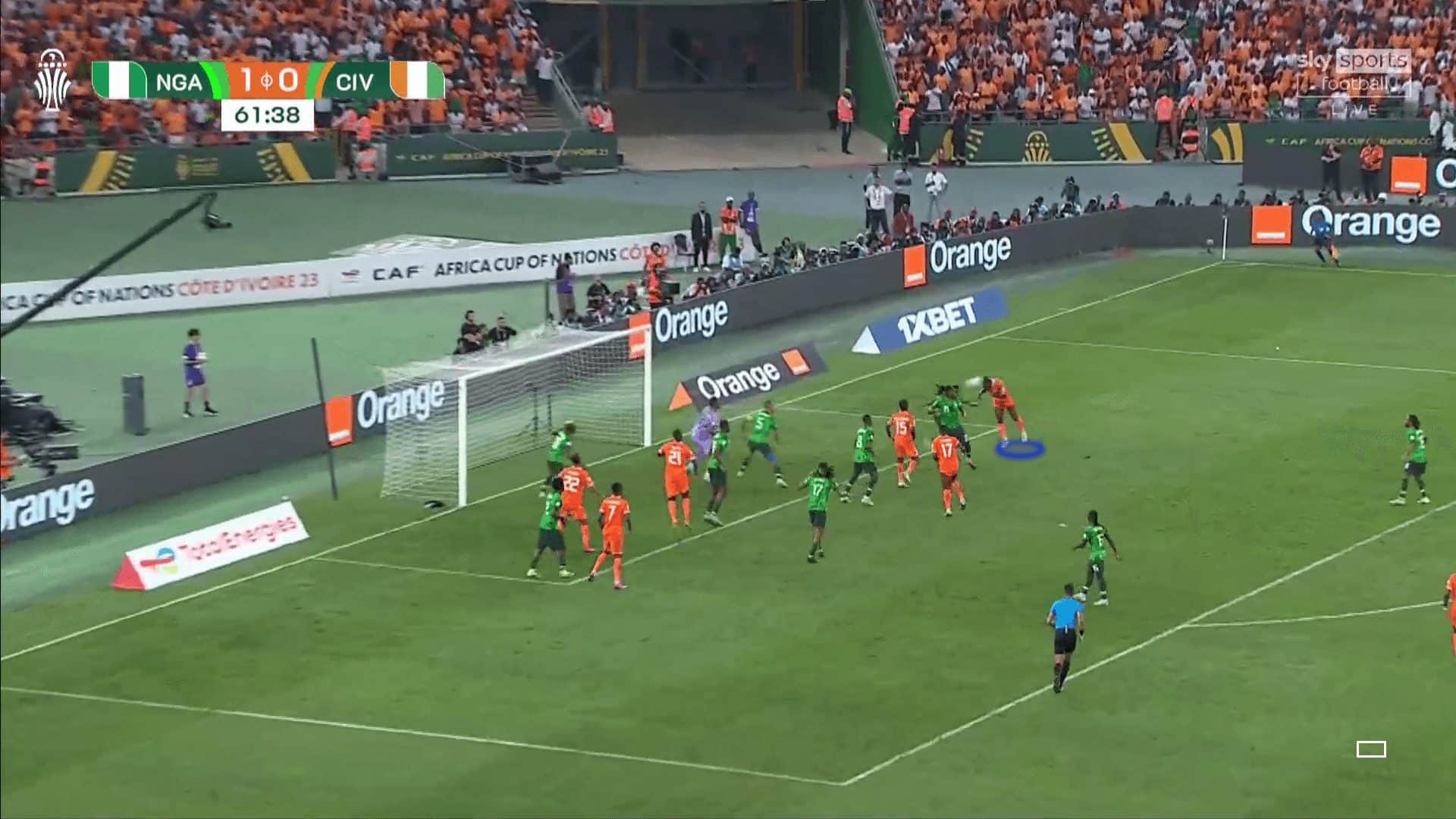
Conclusion
In this analysis, we have explained how the final match of the African Cup of Nations 2023 between Ivory Coast and Nigeria unfolded and how Ivory Coast dealt with Nigeria’s attack, taking advantage of their mistakes in their group stage match, which ended with Nigeria’s 1-0 victory.
We also explained the elephants’ intentions during possession, how their stars individually contributed to this victory, and how set pieces played an essential role in this final.






Comments